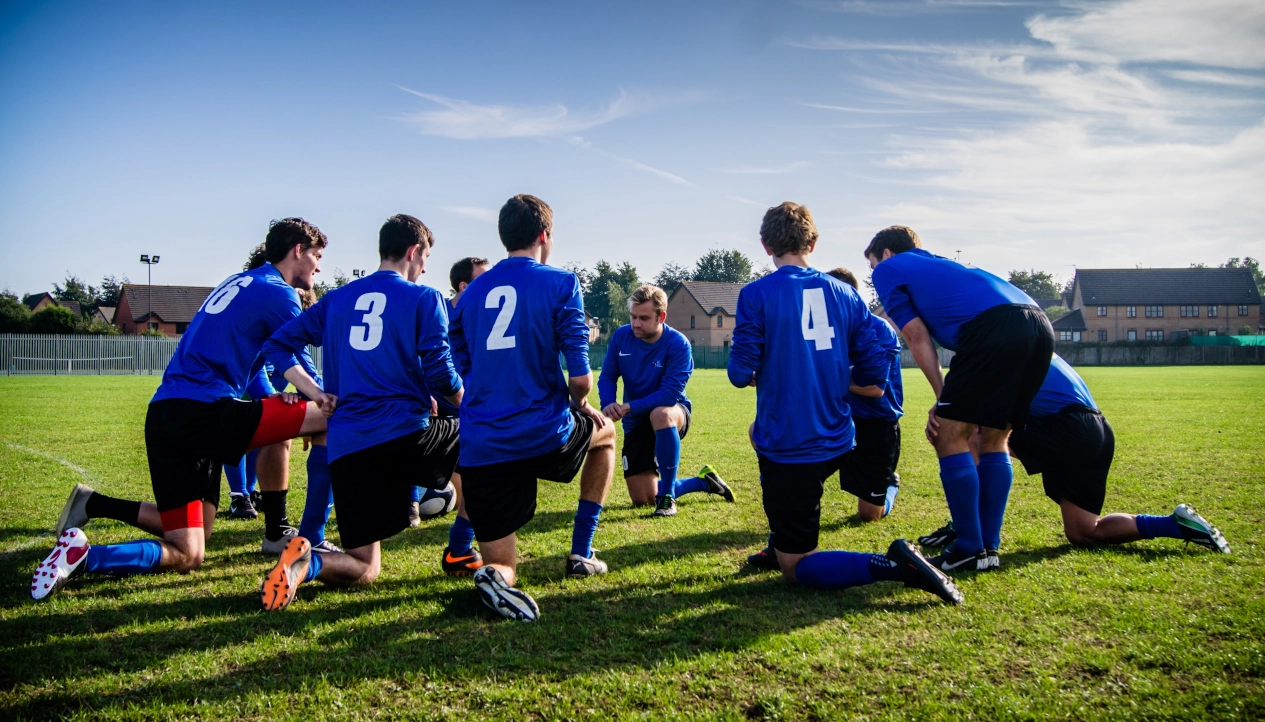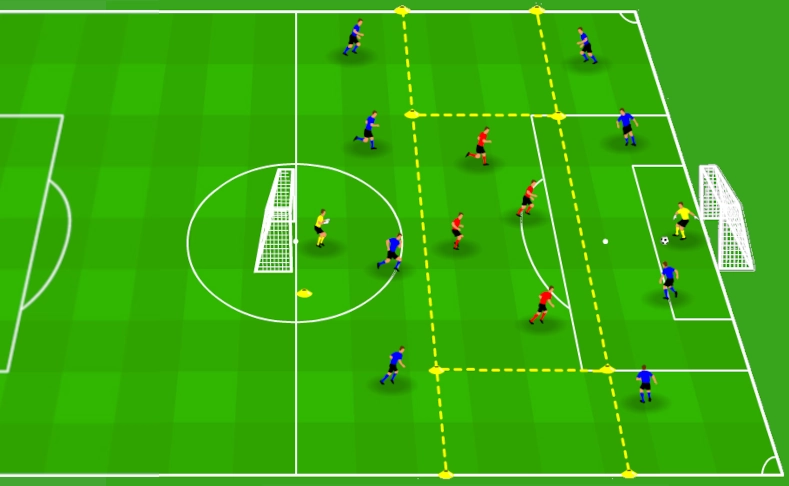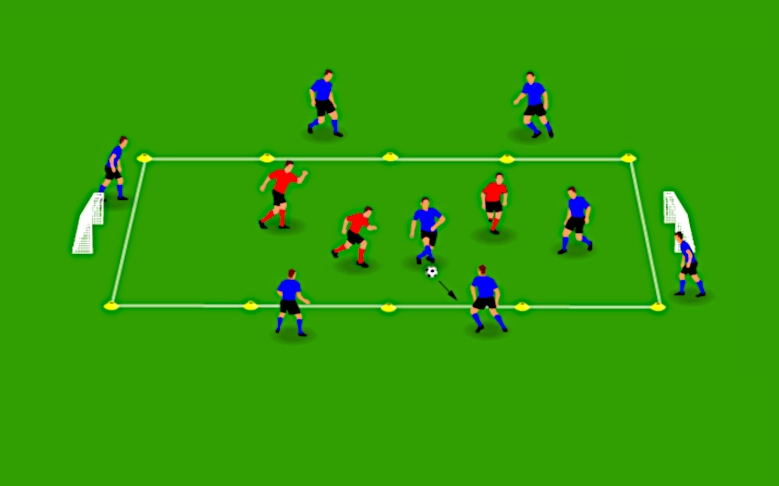5 football drills to improve communications

Communication is essential in any team sport. A team where players communicate well is more effective in attack and defence. This post outlines 5 simple drills to improve communications in your team.
Why is communication essential in football?
When players communicate effectively and consistently, they will have a heightened sense of their teammates’ movements on and off the ball. Communication also builds trust as players rely on each other to make the right decisions.
Many of the greatest players in football have been loud or expressive on the field. Maradona, Gascoine, Eric Cantona, and Cristiano Ronaldo are some prominent examples. They were outspoken in and out of the pitch. However, players don’t need to have an extrovert personality to be good communicators in the field. Messi is the best example of a shy player who constantly communicates with his teammates, and as he approaches the end of his career, he is getting better at it. So, communication is not about who shouts the most in the field.
Communication can be verbal or non-verbal. When it is verbal, it must be concise and to the point (e.g., “man on”, “shoot”, etc.). Non-verbal communication is when players use body language. For example, eye contact or hand signals can be as effective and often more appropriate than a verbal cue. Perhaps the most common non-verbal communication example is hand signals in corner kicks. When players combine both methods of communication, they can provide more information to their teammates, which will help them make quicker and better decisions on or off the ball.
Common phrases to use
It is essential to have a common language for verbal communication. For example, have you ever wondered how professional players from different nationalities work together during a game? The answer is simple; they only need a few key phrases. Preferable, one-word instructions. The list below includes the most commonly used expressions:
- Man on. Indicates a player in possession of the ball, or about to receive it, that an opponent is close by. For example, players shout this expression when a teammate is with their back to the opposition goal and is about to turn, but defenders are closing down. When players hear the instruction, they will look for a back or side pass option instead of turning.
- Time. It is the opposite of Man on. There is no immediate pressure, especially from behind, and the player has Time to collect the ball and look for options.
- Back. This word indicates that a teammate is open for a back pass. It is often used instead of Man on.
- Turn. It is an alternative to Time that provides a bit more information. As a player receives the ball facing away from the attacking goal, it tells them it is safe to turn it upfield.
- Switch. Instructs players to move the ball from one side of the field to the other. The type of switch chosen depends on the context. For example, it may tell the player with the ball to kick it from one side of the field to the other. Or, it may indicate players to change the attack to the other side of the field by moving the ball via the mid-field players.
- Shoot. This command is self-explanatory. Players shout it to ask a teammate to finish a play rather than losing the ball and risking a counterattack. Other times, it indicates an opportunity, such as a goalie out of position.
- Name’s ball. It is a reflex to call “mine” when claiming a ball (often in airborne situations). Unfortunately, although it is better than saying nothing, this command is not good enough. Players may sometimes not know if a teammate or an opposition player called it. In addition, in some leagues (often amateur), referees call a free kick if they consider the situation dangerous or an attempt to distract the opposition. So, players should avoid “mine” and shout their name instead.
The phrases above are probably enough for the drills described in the following section. Look at this post: On-field oral communications for a complete list of commands. Whatever phrases you agree to use, use expressions that are short, concise, and to the point; keep consistency; and avoid terms that have different meanings and can create confusion.
Man on & Time
This is a simple passing drill that only needs two players. So, you can practice in pairs with your whole team or even at home with a friend. It is usually used as a warmup exercise.
Set two gates with cones, and separate the gates with enough distance to practice passing the ball. All that players do is pass the ball to each other while they stay behind and between the cones. The catch is that players must shout out loud Man on or Time when they pass the ball. When the player passing the ball calls Man on, the receiving player must return the ball using one touch. When the player passing the ball shouts Time, the receiving player must use 2 touches.
Add penalty points to make this drill more interesting. For example, when players don’t shout a command or the receiving player uses the wrong number of touches to return the ball. The player with more points at the end of the drill is punished with a fitness exercise (e.g., planks, press-ups, etc.)
Numbers
Divide your team into 4 player groups. Using cones, mark a zone of 5m x 5m for each group and ask players to distribute outside the square evenly. Give each player a number from 1 to 4.
The exercise is a simple passing drill with a twist. When players pass the ball, they shout a number to the teammate receiving it. Then, the player receiving the ball must pass it to the player who was given the number indicated. If a player can’t remember who was assigned the number, they must pass the ball back to the teammate who just passed it to them.
If a player gives the ball to the wrong player, they get a penalty point. Players also get points against them if they step inside the box or their pass is inaccurate (more than a meter away from their target). Run this drill for 10 minutes or so. The players with the lower scores in each group win. You can punish the losers with planks or press-ups.
A quiet place
The title is inspired by the movie A Quiet Place, a thriller where a family must navigate their lives in silence to avoid mysterious creatures that hunt by sound.
Divide your team into two squads and play a regular football game. The catch is that players are not allowed to talk. They must say nothing, nada. A free-kick is given to the opposition when a player speaks or complains.
This drill encourages two aspects of the game. Firstly, it teaches discipline as players will be less likely to constantly complain to referees, teammates, and opposition players. Secondly, it encourages players to use non-verbal cues.
Players will also realise how important it is to communicate by playing this game. As a side benefit, players will also improve their field scanning and space awareness as they won’t rely on instructions from their teammates.
A not-so-quiet place
This communication drill is a variation of the previous game. In this case, players can speak but only use a limited number of commands. Before starting the drill, your team must agree to the list of phrases allowed. Free kicks are given when a different instruction to those agreed is shouted.
The idea of this game is for your team to automatise a list of commands. Then, on game day, they will naturally communicate using a set of agreed phrases.
A variant to this game is to force players to provide instructions before passing the ball. For example, shouting Time or Man On. Again, give a free kick if players don’t call instructions.
Goalkeepers game
Goalkeepers have to be the loudest in the team. Their voice must be loud and clear in crosses, corner kicks, and situations where the defence needs to be organised.
In addition to the commands listed above, goalkeepers use two more: Keepers and Away. Keepers indicate to field players that the goalkeeper is coming to collect the ball. This instruction helps avoid collisions with the goalkeeper. Goalkeepers often use it in corner kicks, crosses and easy balls coming into the box. On the other hand, Away tells defenders to react and focus on clearing the ball to safety. It is common to hear the goalkeeper shouting this instruction when the ball bounces in the box after a corner kick or similar situations, and strikers rush in to shoot at the goal.
A fun drill to encourage goalkeeper communication with the team is to run a 5v5 regular game where only the goalkeeper can talk. The field players can only pass the ball or shoot when the goalkeeper commands it. In addition to the commands listed in this post, goalkeepers must tell the player running with the ball the teammate they want to pass it next. This forces players to listen to their goalkeeper and the goalkeeper to be very vocal.
Like in the other drills, award a free kick when a field player talks. In addition, award a free kick if a field player doesn’t follow instructions (e.g., passes the ball to a different teammate than the one indicated by the keeper).
I hope you find these drills useful. If you like this post, please share it with your friends. If you know other exercises or have questions, leave a comment on our Facebook page.



